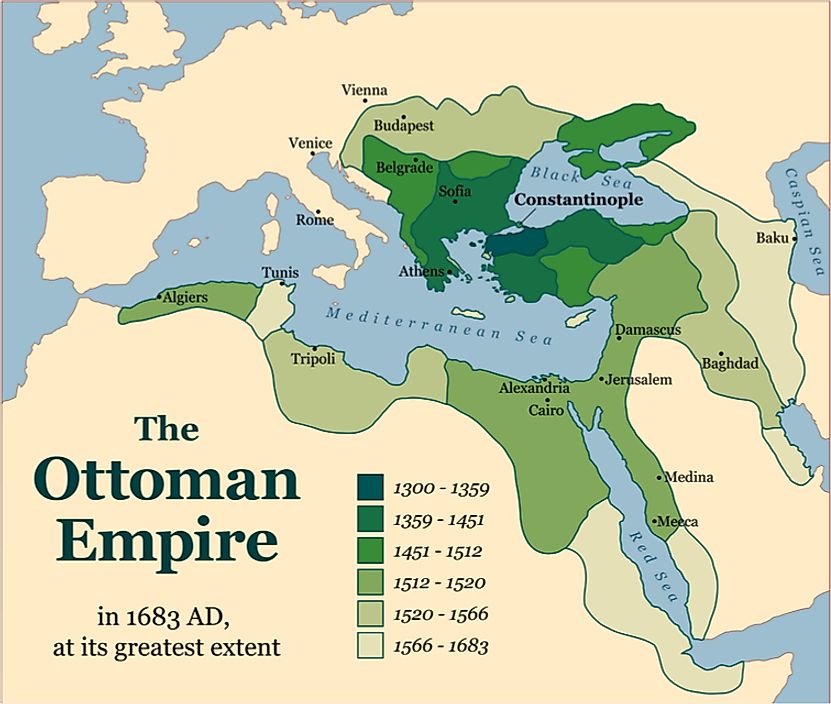Why Did the Ottoman Empire Fall?

What Was the Ottoman Empire?
The Ottoman Empire was first established in the northwestern region of present-day Anatolia by Osman, a tribal leader, in the late 1200s. By the mid-14th century, the Ottomans had made their way west and taken control of the Balkans. Just 100 years later, the Ottoman Empire helped overthrow the Roman Empire, and by the 17th century the Ottoman Empire had expanded into areas of western Asia, southeastern and central Europe, northern and northeastern Africa, and the Caucasus. In total, at its most expansive reach, the Ottoman Empire covered 2 million square miles and controlled a population of approximately 15 million. It is remembered as one of the largest and most powerful empires in human history.
When Did the Ottoman Empire Fall?
This empire lasted for approximately 600 years, and began to lose political power and military advantage in the late 18th century. By the mid-19th century, the Ottoman Empire had implemented a reform aimed at modernization and secularization in an attempt to gain back some of its lost power. These attempts were largely unsuccessful, and by World War I the empire was in full decline. The Ottoman Empire fought against Great Britain, the United States, France, and Russia during the fighting. When the war ended, the empire was dismantled. Historical records indicate that the Ottoman Empire officially ended in 1922.
How Did the Ottoman Empire Fall?
The Ottoman Empire began to decline in the late 18th century as the result of a relatively peaceful period of time experienced in the middle of the century. In most political situations, peace is the ultimate goal; for the Ottoman Empire, however, it meant that military advancements became less important. This military neglect allowed rival European and Russian forces to become more powerful. As a result, the Ottoman Empire lost territory during both the Austro-Turkish War (1716-1718) and the Russo-Turkish War (1768-1764).
Modernization reforms gave the empire one last grasp at power, however it continued losing territory during the 19th century. Additionally, many of its residents began to lose identity as subjects of the Ottoman Empire and began to develop independent nationalistic identities, particularly in the Balkans region. This revolt against the empire reached its climax during the Serbian Revolution, which occurred between 1804 and 1815. By the mid-19th century, it was clear to nearby political powers that the Ottoman Empire was failing.
In 1911, the Ottoman Empire lost land to Italy during the Italo-Turkish War, followed by a loss of all of Balkan territories during the First Balkan War (1912 -1913). Prior to and during this war, the empire faced rebellions from various ethnic groups, including Kurds, Armenians, and Arabs. Additionally, Kuwait became an independent nation as a result of the Anglo-Ottoman Convention of 1913.
On October 29, 1914, the Ottoman Empire attacked Russia on the shores of the Black Sea, effectively prompting the beginning of World War I. In response to this attack, Britain and France allied with Russia and declared war on the Ottoman Empire. On October 31, 1918, the governments involved signed the Armistice of Mudros, which ceased fighting between the empire and the allies. This agreement, however, did not bring peace to the region. The British maintained control of Iraq, Syria, and Palestine, while Allied forces moved into Constantinople with the intention of bringing peace to the violence-filled zone. The Treaty of Sevres of 1920 officially gave control of much of the Middle East to Great Britain and France, leaving the empire with only small areas in Anatolia. At the same time, Turkish nationalists were gaining power in the empire, which resulted in the Turkish War of Independence. With the end of this war, the Ottoman Empire was officially ended in 1922, and the Republic of Turkey was officially established shortly after.











